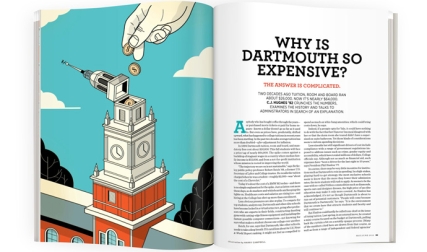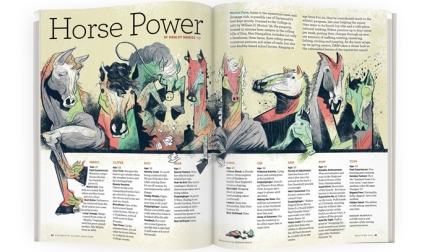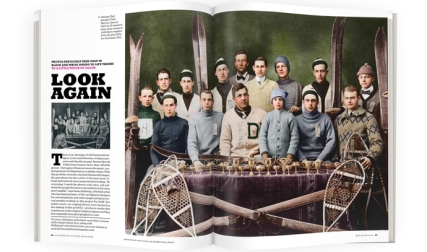Matt Royer can’t help but cringe when he remembers the Watson Run sting. In December 2009 agents from the Environmental Protection Agency raided 24 farms in Lancaster County, Pennsylvania, looking for water-quality violations. They found plenty: open manure pits, waste flowing into streams, rampant erosion—all clear infractions of environmental laws, whose goal was to protect the Chesapeake Bay. The farmers were cited and fined thousands of dollars.
The sting operation was swift, decisive—and a public relations disaster. “They came in guns ablazin’,” one local farmer told The New York Times. The feds hadn’t even known before they stormed in that most of the farms were Amish.
At the time, Royer was a staff attorney for the Chesapeake Bay Foundation, an environmental group dedicated to saving the nation’s largest estuary. He lobbied for stricter laws and regulations, and, when necessary, sued farmers, factories and government agencies to make sure the laws were obeyed. It was the kind of save-the-world job that idealistic law students dream of landing, but Royer couldn’t avoid one inconvenient truth: It wasn’t working, and the bay was in trouble.
During the last decade massive “dead zones” had appeared, areas where algae blooms had sucked up all the oxygen so that nothing else could live. Strange diseases were killing off fish by the thousands, crab harvests had plummeted and the population of legendary Chesapeake Bay oysters, once considered the greatest in the world, had dwindled almost to extinction. Meanwhile, the lawsuits Royer filed and the regulations he helped write seemed to produce more conflict than progress. Episodes such as the sting convinced him there had to be a better way, such as getting farmers and landowners to do the right thing voluntarily, without rules, regulations, lawsuits and raids. What if, instead of being dictated from above, saving the bay became a team effort?
In 2010 Royer quit his job and went home to save the Conewago, the stream he grew up on, just two dozen miles from Watson Run. There he’s helped pioneer a radically different approach to saving the Chesapeake, one that emphasizes cooperation over confrontation and voluntary measures rather than regulations and penalties.
“I’ve been a creek kid all my life,” Royer, 44, says. “I was always the one falling in, getting wet. My shoes were always muddy.” It’s a warm, overcast day in early October, and the sky can’t decide if it wants to rain on us. Royer has driven down from his office at Penn State, where he’s director of the agriculture and environment center of the college of agricultural sciences, to give me a day-long tour of his real “office,” the watershed of the Conewago Creek.
A small tributary of the Susquehanna, which feeds into the Chesapeake Bay about 60 miles downstream, the Conewago meanders for a couple dozen miles between low wooded hills and picture-perfect dairy farms. Its watershed occupies just 50 square miles, or less than 0.1 percent of the total land area of the enormous Chesapeake Bay watershed, which sprawls across five states. There are hundreds, if not thousands, of streams like it that feed into the bay. Royer just happened to grow up on this one.
The Conewago begins as a series of springs and seeps in the woods near an artsy, turn-of-the-century cottage community called Mt. Gretna, where Royer and I were once neighbors. He was best known as a painter. One year one of his oils was chosen as the cover for the annual summer events calendar. Little did the other artists in town know that they’d lost to a former college linebacker. In fact, Royer may be the finest artist the Big Green defensive line has ever produced.
He chose Dartmouth for the same reasons that other smart country kids gravitate to Hanover. “I remember driving up I-91 and falling in love with the terrain, just the forest and the hills and the river,” he says as we make our way down Pennsylvania Route 117, parallel to the creek. “I just loved it.”
He majored in biology, with an unofficial minor in trout fishing in Vermont and on the College Grant. Creek kid. When he wasn’t in the lab or pummeling tackling dummies, he took painting classes from Esmé Thompson. Next came law school at Duke and a clerkship with Ernest C. Torres ’63, a federal district judge in Rhode Island. That led to a law firm job, where Royer learned that he didn’t much like confrontation. “My first experience was taking the deposition of some poor sap who had been in a car accident, and the company was trying to screw him out of money,” he says. “I was like, this is not for me.”
He fled to the Pennsylvania Department of Environmental Protection, a natural place for a guy whose senior project had been a detailed analysis of the recently passed Pennsylvania Nutrient Management Act. That job, in turn, eventually led him to the Chesapeake Bay Foundation.
The term “nutrients”—a bureaucrat’s way of saying manure—comes up a lot during our day together: The main culprit in polluting the bay, according to Royer, is an excess of them washing into the bay from upstream. In Pennsylvania farm country, manure (sorry, nutrients) is the stuff of life. It pours out of cows and chickens, and it has to go somewhere. Much of it is spread on fields as fertilizer, a highly fragrant process that is rarely mentioned in the local tourist brochures. From there, it’s a pretty quick downstream journey to the Chesapeake.
For centuries the local farmers had allowed their cows to walk in and drink from the streams, creating opportunities for what Royer euphemistically calls the “direct discharge of nutrients,” or pooping in the creek. One of most important steps to improving the health of the bay was simply to stop that from happening. But this meant getting the farmers to fence off their streambanks and keep the cows out of the creeks altogether—not an easy sell to eighth-generation farmers who had always done things that way.
Thanks to the Watson Run debacle, Royer also saw that regulations and fines would go only so far—he had to get the farmers and the conservationists on the same side. But how? The farmers he knew had an inherent suspicion of environmentalists, whom they viewed as responsible for a growing maze of state and federal regulations that they had to navigate. The election of Barack Obama and the local strength of the Tea Party only heightened the sense of polarization, which is why Royer’s first move, leaving the environmental group, was also a brilliant one: He had distanced himself from one side of the standoff.
He was now director of something called Conewago Creek Collaborative Conservation Initiative, a mouthful of a name for a group that, at first, had few members. Royer worked patiently, holding meeting after meeting during a two-year period with local landowners, community boards and officials from the three counties and seven townships where the Conewago flows, trying to get everybody on board. “Free food was an important part of these meetings,” he says with a laugh.
It helped that he’d grown up on a chicken farm and knew a thing or two about nutrients. It didn’t hurt that he’d been a local high school football star. But Royer’s main asset was his personality. “Matt’s
credibility comes from who he is,” says Steve Letavic, township manager of Londonderry Township. “He is very down to earth, he can talk to anybody and he understands people’s concerns. One of his greatest assets is that he is as comfortable talking to farmers and people in the woods as he is in the boardroom. He’s easy to work with.”
We stop at a one-lane bridge over what looks like a weed-choked ditch. It’s not even a stream, just a tiny tributary of the Conewago, barely a dozen miles from the source, and it isn’t very appetizing. The water is murky and sluggish, like old dishwater, and the banks are overgrown with invasive plants. This, Royer says, is what the Conewago used to be like: the water brown and silty, no trout and few bugs. Just upstream is a farm with serious erosion problems. “The stream gets hammered from the start,” he says. “On a quality scale of 1 to 100, I’d give it a 20.”
But there are signs of progress: Royer points out a series of plastic tubes sticking out of the ground in an adjacent field. Each one contains a baby tree. (The tubes protect them from deer and other herbivores.) He explains that this field will become a forest and the trees will stop erosion, kill off invasive plants and shade the stream to make it suitable for fish. The bad news? It could take a decade or more.
Royer’s plan for the Conewago consists of thousands of small elements such as the tree planting, funded with grant money that he has shaken loose from the state and private donors—and, notably, Penn State, which gave him money and a job title and an office. The university sees the Conewago project as a kind of laboratory for cutting-edge conservation practices.
The key to making it work is convincing landowners to take small, voluntary actions on their own properties. He persuaded farmers such as Jay Kopp, a third-generation dairy farmer who has 150 cows in the watershed, to plant cover crops to keep soil in place, and homeowners to install rain barrels to catch runoff from their gutters rather than let it flow into the creek and cause erosion during rainstorms. “We tell farmers they need to grow clean water,” says Letavic.
“The environment is suffering from a death by a thousand cuts,” says Nicholas DiPasquale, director of the EPA’s Chesapeake Bay office. “This is healing some of those cuts.”
Our last stop is not only Royer’s biggest success on the Conewago, but also one of his sweet secret fishing spots: a once-barren streamside meadow now bristling with willows and shrubs, barely a mile from the ditch we’d visited earlier. We unload our rods from the trunk and tromp across a meadow, part of a 20-acre tract owned by the Hershey Trust, and he points out a wetland area the size of a football field. In rainstorms it fills with water, plants, birds and frogs. It’s a constructed wetland, built to retain storm water and create habitat. And it’s working.
Royer is holding forth on nonpoint-source pollution and maximum total daily loads when we both spot a huge bird flying toward us on broad, heavy wings. Royer freezes in his tracks. “That’s a bald eagle!” he shouts. “Wow! Holy crap. I’ve never seen one here.” The eagle is here for the same reason we are: the fish. And the fish are here because this section of the creek is the Conewago initiative’s most ambitious project. The creek, once a steep-banked, eroded ditch, has been completely re-engineered with help from state grants and the enthusiastic cooperation of the trust. Using heavy machinery and volunteers, the initiative re-configured the whole stream course, installing features that mimic an untouched, natural creek, such as mud sills and log veins that help tame floodwaters while creating habitat for fish. The floodplain was planted with bushes and trees, which is where the eagle was hanging out before we showed up.
After five years of tireless proselytizing, Royer can point to progress made. A 2012 stream survey found a dozen species of fish, including several that are considered intolerant of dirty water—a 2007 baseline sampling attempt had found none. The project has been so successful that in 2012 Royer moved to State College, Pennsylvania (“I am the center,” he says of his Penn State job), where he’s trying to replicate the Conewago project across the state, cleaning up the bay one watershed at a time—or rather, one farm at a time.
The idea seems to be catching. Even the farmers on Watson Run have seen the light, taking voluntary measures to help clean up their stream. The EPA has backed off to let the locals handle things. “This is the direction we should be moving in, with respect to dealing with locals and allowing locals to figure out the issues,” says DiPasquale of the EPA, which has sworn off Watson Run-style tactics.
For now it’s all about spending the afternoon fishing. Even though we’re wedged between the Pennsylvania Turnpike and a busy secondary road, it’s a lovely, serene place. “It’s a phenomenal spot,” Royer says as he rigs up his fly rod. He hooks a fish on the second cast.
Bill Gifford is the author of Spring Chicken: Stay Young Forever (or Die Trying), about the science of aging.




